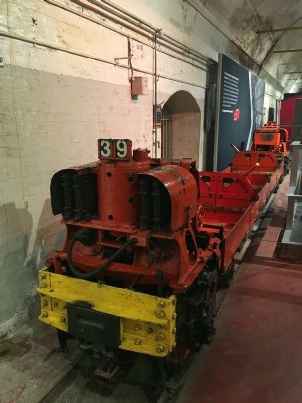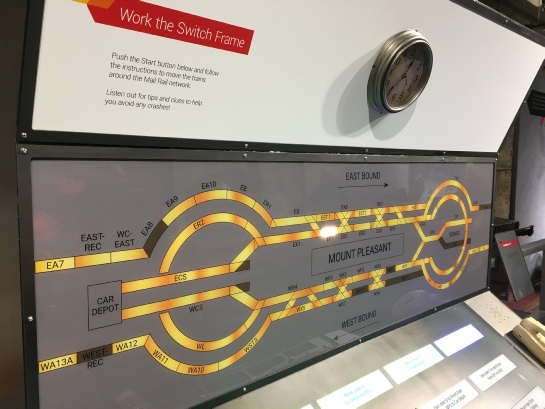Archive Section




Tuesday 3rd April 2018.
© Text & photos Stuart Smith.
Following on from the excellent talk given in March by Chris Taft (Head of Collections, Postal Museum), I arranged this visit to give an opportunity to gain further knowledge of one of this countries great ‘services’, and in particular, to ride on and explore part of the Postal Railway which runs underneath the streets of central London. 18 members met just before 11 am, and once tickets and passes had been distributed, we entered the exhibition part of the museum.
To explain briefly, the Postal Museum is split into two parts. The exhibition hall which houses the main collection of artefacts and historical items (uniforms, equipment, vehicles, post boxes, trolleys....), plus interactive displays and film shows, such as Night Mail by WH Auden and clips from the Great Train Robbery. This section also contained a large array of items in connection with stamps & postage, plus the changing world of the humble post office and its role in local life.
We had just under an hour to explore in here before making our way to the opposite side of the road to the second part of the Museum. Mail Rail is a 15 minute ride on the former Post Office railway, through the tunnels at Mount Pleasant Sorting Office.
Another ticket check saw us allowed to descend into a huge underground area, which was formally occupied by Mount Pleasant Depot. Within a few minutes the sound of a rumbling train could be heard, and from the small tunnel mouth, emerged an even smaller green train.
These trains (there are two of them -
Green Train Built by Severn-
21625 & 21626 -
Red Train Built by Severn-
21630 & 21631 -
Once the previous set of passengers had detrained (and straightened themselves upright again!!), it was our turn to board. Our group of 18 filled the train to almost its maximum (it can take 21 allegedly, but I think you’d all have to be quite small to fit) before the roof top hatches were closed and locked -
So, off we set into the darkness....
Well, not really, as the tunnel sections are now fully lit (unlike when used as a working railway). A short safety briefing is given during the downhill descent to the main tunnel, and then a very informative account follows, with mention of the previous historical and current operating procedures. Several sets of disused lines and sidings were noted heading off in various directions, including, notably, the tunnel entrance to the former eastbound route towards Liverpool Street.
A few items of redundant rolling stock were noted abandoned on sidings and spurs as we went along. Around half-
After a few minutes, and once the signal clears, (this is to ensure the two-
Several items of former rolling stock, including mail carrying wagons, PW equipment and even a TPO van are viewable. At its peak, over 4 million letters were carried every day.


The former tunnel towards Liverpool Street diverges
The red train arrives from the tunnels into Mount Pleasant
200 dedicated staff worked in shifts to keep everything working: from postal staff, to cleaners and maintenance engineers. It was considered a privilege to work for this ‘underground’ team. The idea for a postal railway was first suggested in 1909, by Robert Bruce. At that time, Mail travelled at barely 7 mph through the congested streets of London. Construction began in 1914, with the tunnels being dug around 20 metres below the road surface.
Following some delays due to wartime activity and the subsequent destruction, the railway opened in 1927, and straight from the start, driverless trains were able to operate at speeds of up to 30 mph on the two-
Prior to Mail Rail, the Victorians experimented with a pneumatic driverless system in 1863. The cars ran along metal rails, (propelled by air-
Sixty years after its original opening, the system had a total makeover and was re-
The railway was used as a location for the 1990 film Hudson Hawk, staring Bruce Willis. Several locations were transformed to resemble an underground railway, supposedly situated beneath the Vatican City.
All in all, a quite remarkable railway, which due to its location (underground), many Londoners probably don’t even know it exists?


Two of the former mail–carrying trains



The green train waits to depart
The signalling diagram for the Mount Pleasant station area

The track layout -
The sole surviving pneumatic mail car -